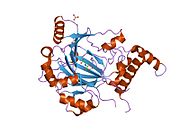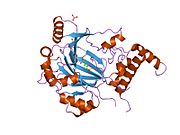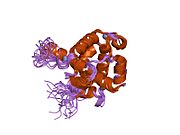HIF1A
Ensembl | |||||||||
|---|---|---|---|---|---|---|---|---|---|
| UniProt | |||||||||
| RefSeq (mRNA) | |||||||||
| RefSeq (protein) | |||||||||
| Location (UCSC) | Chr 14: 61.7 – 61.75 Mb | Chr 12: 73.95 – 73.99 Mb | |||||||
| PubMed search | [3] | [4] | |||||||
| View/Edit Human | View/Edit Mouse |
Hypoxia-inducible factor 1-alpha, also known as HIF-1-alpha, is a subunit of a heterodimeric
HIF1A is a
Structure
HIF1 is a
Gene and expression
The human HIF1A gene encodes for the alpha subunit, HIF1A of the transcription factor hypoxia-inducible factor (HIF1).
Function

The transcription factor HIF-1 plays an important role in cellular response to systemic oxygen levels in mammals.
HIF1A stability, subcellular localization, as well as transcriptional activity are especially affected by oxygen level. The alpha subunit forms a heterodimer with the beta subunit. Under
Repair, regeneration and rejuvenation
In normal circumstances after injury HIF1A is degraded by prolyl hydroxylases (PHDs). In June 2015, scientists found that the continued up-regulation of HIF1A via PHD inhibitors regenerates lost or damaged tissue in mammals that have a repair response; and the continued down-regulation of HIF1A results in healing with a scarring response in mammals with a previous regenerative response to the loss of tissue. The act of regulating HIF1A can either turn off, or turn on the key processes of mammalian regeneration.[44][45] One such regenerative process in which HIF1A is involved is peripheral nerve regeneration. Following axon injury, HIF1A activates VEGFA to promote regeneration and functional recovery.[46][47] HIF1A also controls skin healing.[48] Researchers at the Stanford University School of Medicine demonstrated that HIF1A activation was able to prevent and treat chronic wounds in diabetic and aged mice. Not only did the wounds in the mice heal more quickly, but the quality of the new skin was even better than the original.[49][50][51][52] Additionally the regenerative effect of HIF-1A modulation on aged skin cells was described[53][54] and a rejuvenating effect on aged facial skin was demonstrated in patients.[55] HIF modulation has also been linked to a beneficial effect on hair loss.[56] The biotech company Tomorrowlabs GmbH, founded in Vienna in 2016 by the physician Dominik Duscher and pharmacologist Dominik Thor, makes use of this mechanism.[57] Based on the patent-pending HSF ("HIF strengthening factor") active ingredient, products have been developed that are supposed to promote skin and hair regeneration.[58][59][60][61]
Regulation
HIF1A abundance (and its subsequent activity) is regulated transcriptionally in an
PHDs rely on iron among other molecules to hydroxylate HIF1A; as such, iron chelators such as
Factors increasing HIF1A[66]
- Modulator of Degradation:
- Oxygen-Dependent:
- EPF UCP (degrades pHVL)
- VDU2 (de-ubiquitinates HIF1A)
- SUMOylation (via RSUME)
- DeSUMOylation ( via SENP1)
- Oxygen-independent:
- RACK1)
- Oxygen-Dependent:
- Modulators of translation:
Factors decreasing HIF1A[66]
Role in cancer
HIF1A is overexpressed in many human cancers.[67][68] HIF1A overexpression is heavily implicated in promoting tumor growth and metastasis through its role in initiating angiogenesis and regulating cellular metabolism to overcome hypoxia.[69] Hypoxia promotes apoptosis in both normal and tumor cells.[70] However, hypoxic conditions in tumor microenvironment especially, along with accumulation of genetic alternations often contribute to HIF1A overexpression.[10]
Significant HIF1A expression has been noted in most solid tumors studied, which include cancers of the
Studies of[71] HIF1A overexpression in tumors may also occur in a hypoxia-independent pathway. In hemangioblastoma, HIF1A expression is found in most cells sampled from the well-vascularized tumor.
During hypoxia,
While research efforts to develop therapeutic drugs to target hypoxia-associated tumor cells have been ongoing for many years, there has not yet been any breakthrough that has shown selectivity and effectiveness at targeting HIF1A pathways to decrease tumor progression and angiogenesis.
Interactions
HIF1A has been shown to
See also
- Hypoxia inducible factors
References
- ^ a b c GRCh38: Ensembl release 89: ENSG00000100644 – Ensembl, May 2017
- ^ a b c GRCm38: Ensembl release 89: ENSMUSG00000021109 – Ensembl, May 2017
- ^ "Human PubMed Reference:". National Center for Biotechnology Information, U.S. National Library of Medicine.
- ^ "Mouse PubMed Reference:". National Center for Biotechnology Information, U.S. National Library of Medicine.
- PMID 8786149.
- ^ S2CID 14908247.
- ^ a b c "Entrez Gene: HIF1A hypoxia-inducible factor 1, alpha subunit (basic helix-loop-helix transcription factor)".
- ^ PMID 7539918.
- PMID 9436976.
- ^ S2CID 2448376.
- PMID 29105383.
- S2CID 23881074.
- S2CID 19885003.
- PMID 9782081.
- ^ "Hypoxia-inducible factor 1-alpha". 2014.
- ^ "HIF1A". National Center for Biotechnology Information.
- ^ "Anti-HIF1 alpha antibody (GTX127309) | GeneTex". www.genetex.com. Retrieved 2019-10-28.
- ^ PMID 10425220.
- PMID 41725.
- PMID 9398602.
- PMID 8753788.
- PMID 9486205.
- PMID 9027739.
- S2CID 15292804.
- PMID 10611972.
- S2CID 2395367.
- ^ S2CID 41613739.
- PMID 11927290.
- S2CID 9695199.
- ^ S2CID 18372306.
- S2CID 33725562.
- S2CID 20914281.
- ^ PMID 11566883.
- S2CID 11397503.
- PMID 9159130.
- S2CID 32080596.
- S2CID 4388644.
- ^ S2CID 19641938.
- PMID 34575844.
- PMID 14982858.
- ^ S2CID 24045310.
- PMID 11940656.
- PMID 27673562.
- ^ eurekalert.org staff (3 June 2015). "Scientist at LIMR leads study demonstrating drug-induced tissue regeneration". eurekalert.org. Lankenau Institute for Medical Research (LIMR). Retrieved 3 July 2015.
- PMID 26041709.
- PMID 26526390.
- PMID 29666508.
- PMID 24804159.
- ^ "Skin patch could help heal, prevent diabetic ulcers, study finds". Welcome to Bio-X. © Stanford University, Stanford, California 94305. 2015-01-23. Retrieved 2020-12-04.
- PMID 25535360.
- S2CID 196350143.
- PMID 30152571.
- S2CID 4473259.
- PMID 32479616.
- S2CID 216031505.
- S2CID 212693280.
- ^ Tomorrowlabs. "Tomorrowlabs". Tomorrowlabs. Retrieved 2020-12-04.
- ^ "Kosmetikbranche: Wie das Beauty-Start-up Tomorrowlabs den Markt erobert". www.handelsblatt.com (in German). Retrieved 2020-12-04.
- ^ "Ein Protein gegen das Altern und für das Geldverdienen". nachrichten.at (in German). Retrieved 2020-12-04.
- ^ "Das neue Beauty-Investment von Michael Pieper - HZ". Handelszeitung (in German). Retrieved 2020-12-04.
- ^ andrea.hodoschek (2020-08-03). "Milliardenmarkt Anti-Aging: Start-up aus Österreich mischt mit". kurier.at (in German). Retrieved 2020-12-04.
- PMID 18393939.
- ^ Rius, J., Guma, M., Schachtrup, C. et al. NF-κB links innate immunity to the hypoxic response through transcriptional regulation of HIF-1α. Nature 453, 807–811 (2008). https://doi.org/10.1038/nature06905
- S2CID 2434206.
- ^ PMID 23983604.
- ^ PMID 18809331.
- ^ PMID 10582706.
- ^ PMID 10934146.
- ^ S2CID 32635739.
- ^ S2CID 21902400.
- ^ S2CID 85532042.
- PMID 11306467.
- PMID 11181773.
- PMID 2375073.
- ^ PMID 11410504.
- S2CID 232300877.
- PMID 11181778.
- ^ S2CID 85168033.
- PMID 11382591.
- ^ PMID 15141023.
- S2CID 20164007.
- ^ S2CID 28480163.
- PMID 10691731.
- PMID 11280732.
- PMID 24220190.
- PMID 9576906.
- S2CID 25125998.
- PMID 10202154.
- PMID 9887100.
- ^ S2CID 31675735.
- PMID 11959990.
- ^ PMID 11641274.
- ^ S2CID 85351036.
- ^ PMID 10640274.
- ^ PMID 18305400.
- PMID 12124396.
- S2CID 4423081.
- S2CID 83756271.
- ^ PMID 18985005.
- ^ PMID 18694926.
- S2CID 22798700.
- PMID 12682018.
- PMID 10944113.
- PMID 11504942.
- PMID 19671042.
- PMID 20631191.
- S2CID 4108143.
Further reading
- Semenza GL (August 2000). "HIF-1 and human disease: one highly involved factor". Genes & Development. 14 (16): 1983–91. S2CID 12788170.
- Semenza G (September 2002). "Signal transduction to hypoxia-inducible factor 1". Biochemical Pharmacology. 64 (5–6): 993–8. PMID 12213597.
- Arbeit JM (2002). "Quiescent hypervascularity mediated by gain of HIF-1 alpha function". Cold Spring Harbor Symposia on Quantitative Biology. 67: 133–42. PMID 12858534.
- Sitkovsky M, Lukashev D (September 2005). "Regulation of immune cells by local-tissue oxygen tension: HIF1 alpha and adenosine receptors". Nature Reviews. Immunology. 5 (9): 712–21. S2CID 30400163.
- Mobasheri A, Richardson S, Mobasheri R, Shakibaei M, Hoyland JA (October 2005). "Hypoxia inducible factor-1 and facilitative glucose transporters GLUT1 and GLUT3: putative molecular components of the oxygen and glucose sensing apparatus in articular chondrocytes". Histology and Histopathology. 20 (4): 1327–38. PMID 16136514.
- Schipani E (2006). "Hypoxia and HIF-1 alpha in chondrogenesis". Seminars in Cell & Developmental Biology. 16 (4–5): 539–46. PMID 16144691.
- Haase VH (August 2006). "Hypoxia-inducible factors in the kidney". American Journal of Physiology. Renal Physiology. 291 (2): F271–81. PMID 16554418.
- Liang D, Kong X, Sang N (November 2006). "Effects of histone deacetylase inhibitors on HIF-1". Cell Cycle. 5 (21): 2430–5. PMID 17102633.
External links
- Overview of all the structural information available in the PDB for UniProt: Q16665 (Human Hypoxia-inducible factor 1-alpha) at the PDBe-KB.
- Overview of all the structural information available in the PDB for UniProt: Q61221 (Mouse Hypoxia-inducible factor 1-alpha) at the PDBe-KB.
- Scientific animation of HIF-1alpha in complex with ARNT on DNA: https://www.youtube.com/watch?v=azIEzLXXyHM






